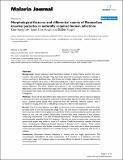Morphological features and differential counts of Plasmodium knowlesi parasites in naturally acquired human infections
Abstract
Background: Human infections with Plasmodium knowlesi, a simian malaria parasite, are more common than previously thought. They have been detected by molecular detection methods in various countries in Southeast Asia, where they were initially diagnosed by microscopy mainly as Plasmodium malariae and at times, as Plasmodium falciparum. There is a paucity of information on the morphology of P. knowlesi parasites and proportion of each erythrocytic stage in naturally acquired human infections. Therefore, detailed descriptions of the morphological characteristics and differential counts of the erythrocytic stages of P. knowlesi parasites in human infections were made, photographs were taken, and morphological features were compared with those of P. malariae and P. falciparum. Methods: Thick and thin blood films were made prior to administration of anti-malarial treatment in patients who were subsequently confirmed as having single species knowlesi infections by PCR assays. Giemsa-stained blood films, prepared from 10 randomly selected patients with a parasitaemia ranging from 610 to 236,000 parasites per mu l blood, were examined. Results: The P. knowlesi infection was highly synchronous in only one patient, where 97% of the parasites were at the late trophozoite stage. Early, late and mature trophozoites and schizonts were observed in films from all patients except three; where schizonts and early trophozoites were absent in two and one patient, respectively. Gametocytes were observed in four patients, comprising only between 1.2 to 2.8% of infected erythrocytes. The early trophozoites of P. knowlesi morphologically resemble those of P. falciparum. The late and mature trophozoites, schizonts and gametocytes appear very similar to those of P. malariae. Careful examinations revealed that some minor morphological differences existed between P. knowlesi and P. malariae. These include trophozoites of knowlesi with double chromatin dots and at times with two or three parasites per erythrocyte and mature schizonts of P. knowlesi having 16 merozoites, compared with 12 for P. malariae. Conclusion: Plasmodium knowlesi infections in humans are not highly synchronous. The morphological resemblance of early trophozoites of P. knowlesi to P. falciparum and later erythrocytic stages to P. malariae makes it extremely difficult to identify P. knowlesi infections by microscopy alone.
Citation
Lee , K-S , Cox Singh , J & Singh , B 2009 , ' Morphological features and differential counts of Plasmodium knowlesi parasites in naturally acquired human infections ' , Malaria Journal , vol. 8 , 73 . https://doi.org/10.1186/1475-2875-8-73
Publication
Malaria Journal
Status
Peer reviewed
ISSN
1475-2875Type
Journal article
Collections
Items in the St Andrews Research Repository are protected by copyright, with all rights reserved, unless otherwise indicated.

